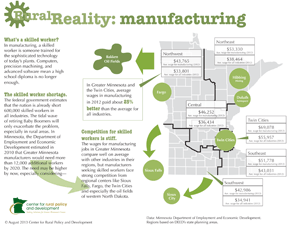Manufacturing’s comeback in Greater Minnesota highlights challenges and opportunities

August 28, 2013
Labor Day 2013 is bringing some good news for today’s Greater Minnesota workers and the potential for new opportunities in the future. Well-paying jobs in manufacturing are an economic cornerstone for Greater Minnesota, according to data analyzed by the Center for Rural Policy and Development. Manufacturing jobs in Greater Minnesota are projected to increase by 9 percent by 2020, compared to a 1 percent increase in the Twin Cities.
Manufacturing’s future in Greater Minnesota could be even brighter if competition for skilled workers doesn’t short-circuit the opportunity.
The Center for Rural Policy and Development evaluated data from several sources to offer both optimism and concern for Greater Minnesota’s manufacturing economy:
- Average wages in manufacturing are about 25 percent higher than wages paid in other industries. In Northeast Minnesota, the pay differential is nearly 40 percent.
- Skilled manufacturing workers are in great demand, with an estimated 12,000 additional workers needed by 2020 – an estimate that may be conservative.
- However, Greater Minnesota manufacturers face stiff competition for skilled workers from the Twin Cities, regional centers in North and South Dakota and the western North Dakota oil fields. The retirement of Baby Boomers will accelerate the competition for skilled workers.
“Manufacturing is a key driver of Greater Minnesota’s economy. Not only are the wages higher than other industries, but there is a tremendous ripple effect from manufacturing. Manufacturing induces more jobs than any other industry,” said Brad Finstad, executive director of the Center for Rural Policy and Development.
“Training tomorrow’s workers will be critical to making sure Minnesota has the skilled workers manufacturers need. It’s especially important to continue the efforts of the Minnesota State Colleges and Universities campuses and other organizations working with manufacturers to identify their needs and develop specialized programs,” said Finstad.
The Center for Rural Policy and Development used data from the Minnesota Department of Employment and Economic Development, the U.S. Bureau of Labor Statistics and the U.S. Bureau of Economic Analysis to examine the state of manufacturing jobs in its September edition of “Rural Reality.” The series of infographics, produced by the Center for Rural Policy and Development, provide a Greater Minnesota perspective on critical issues, challenges and opportunities.
